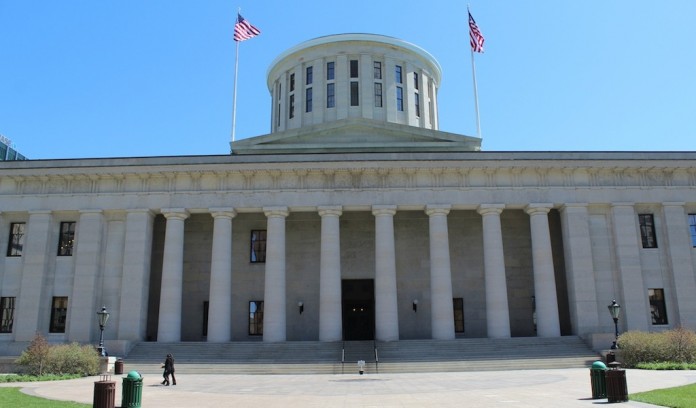COLUMBUS — Ohio farmers and woodland owners being appraised this year will, on average, be paying less than appraisals last year, as a result of lower commodity prices and earlier changes to the Current Agricultural Use Value formula.
But the 23 counties up for their reappraisal or triennial update will still pay more than they did in 2013. And, calls to remove certain non-agricultural factors from the formula and reduce the taxable value of conservation lands were unanswered.
The new values were announced June 2, in a public hearing of the Ohio Department of Taxation’s Ag Advisory Committee. Rates differ across the state based on soil type and productivity.
The 2016 all-soils average has a CAUV value of $1,310 per acre, compared to $1,388 in 2015, and $1,205 per acre in 2013. The highest-producing soil has an average value of $4,750 an acre, up from $3,780 in 2013.
Tax savings
Gloria Gardner, assistant administrator for the tax department’s Tax Equalization Division, said in 2015, Ohio’s CAUV value was only 54 percent of the state’s market value for the same acreage, or about a 46 percent savings versus actual market value tax.
But farmers and farm groups have argued that’s also the point of CAUV — to protect farmland from being taxed at the highest possible use — and to make sure the formula pertains to agricultural factors.
Calls for improvement
The Ohio Farm Bureau and Ohio Farmers Union had both wanted the department to improve the capitalization rate by removing equity buildup and appreciation from the formula, arguing those factors don’t typically pertain to farm production, until a farm goes up for sale.
They also argued that historically low interest rates have unfairly affected the capitalization rate, and that land being taken out of production, for conservation, should be taxed at the lowest allowable value — since it’s not producing a crop.
Legislative effort
Brandon Kern, director of state policy for Ohio Farm Bureau, told the legislature this spring that the average statewide increase in CAUV was 294 percent, from 2008 to 2014, and that farmland taxpayers paid a total of $370 million more in 2014, than in 2008.
Companion bills have been introduced in both the House and Senate to make these improvements, but no votes have been taken.
Gardner said the tax department is aware of the concerns farmers have with the capitalization rate, and said “we are continuing to have internal discussions about that.”
She said the department needs more data to substantiate a decision, but is still reviewing the issue.
“We just need to do more research, I think, before we would consider making any changes,” she said.
Leah Curtis, OFBF’s director of ag law, said the OFBF appreciates the opportunity to serve on the tax committee, but added, “We do remain disappointed that additional steps are not being taken.”
Ted Finnarn, a Darke County attorney who has been on the committee 40 years, and also represents Ohio Farmers Union, said something still needs done about the capitalization rate — and the way low interest rates affect the formula.
“I still think these values are too high for 2016,” Finnarn said. “…There was no way we could know how low (interest rates) would go, and that increases the values unreasonably.”
Looking ahead
If changes are made, Gardner said it would be better to do that without legislation, but she said a lot still has to be decided.
”I’d prefer to make changes, if possible, without legislation, but we’d have to look at the administrative codes and make sure that we’re in compliance to do that,” she said.
The legislature isn’t scheduled to return until November.
Tax shift
Delaware County Auditor George Kaitsa said he supports the changes to the capitalization rate.
Some county auditors have testified against the changes, because it could cause a tax shift to residential property owners. School districts and local governments could also lose money. But Kaitsa said the current formula allowed for too high of a shift onto farmers, first.
“What has been forgotten in this discussion is how much of a shift in the tax burden has occurred from 2011 forward,” he said, shifting away from residential properties and onto farm properties.
Woodland values
The average woodlands value for 2016 is $563 per acre, compared to $727 an acre in 2013.
Gardner said the department has received new data about the cost to clear and drain woodlands — which helps determine the CAUV value for woodlands. She said those new figures could factor into the 2017 tax year, but not 2016.
She said the new values will be sent to county auditors in the coming weeks, and will soon be available for review.
Related coverage:
- CAUV bills on hold in House and Senate committees (May 23, 2016).
- Ohio House committee hears CAUV testimony (May 4, 2016).
- County auditors and farmers testify on CAUV bill (April 29, 2016)
- High real estate taxes pressuring woodland owners and farmers (April 26, 2016).
- First proponent hearing on the Senate CAUV bill (April 12, 2016).
- Ohio lawmakers seek additional CAUV changes (November, 2015).
- Landowners sue Ohio over CAUV calculation (June, 2015).










